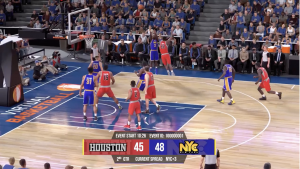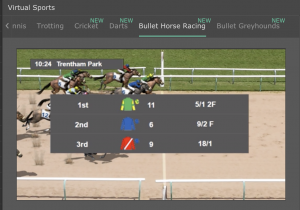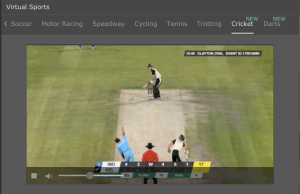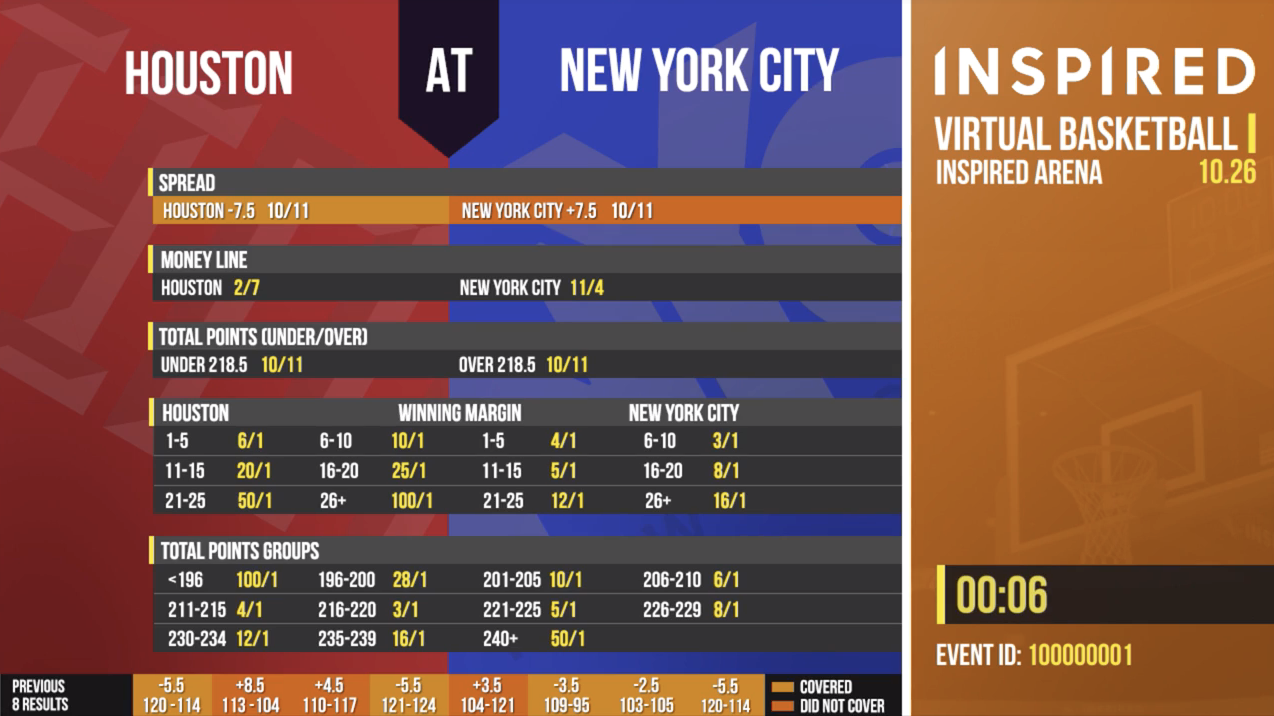A quick look at the Virtual Sports betting industry today reveals that there are essentially two different types of Virtual Sports available to bet on, although both are included under the broad term Virtual Sports.
there are essentially two different types of Virtual Sports available to bet on, although both are included under the broad term Virtual Sports.
The first of these are Virtual Racing games and there are more of these types of games than the other which are Virtual Games. Racing games include Virtual versions of horseracing, greyhound racing, motor sport racing, speedway, trotting and cycling.
When it comes to Virtual Games there are a growing number of options in this market. For many years there was solely Virtual Football but now there is also Virtual Tennis, Cricket, Darts and very soon, Virtual Basketball is believed to be ready to hit many different sports betting sites in the coming weeks and months.
It is easy to see why when developing Virtual Sports betting, companies like Inspired who produce the games, would have tended towards designing race-based games, as opposed to game-based sports.
Why Virtual race-based games were so popular initially
Races tend to be easier to formulate betting markets for as there are fewer bets that you can make. Each race tends to last the same amount of time and it is easy to format a race to last the exact amount of time you want for a Virtual Sports service. Furthermore, once you have a template sorted for how a Virtual Race game works, then you can use that same template and just upgrade certain elements within the Virtual Race to develop a new Virtual Race game.
fewer bets that you can make. Each race tends to last the same amount of time and it is easy to format a race to last the exact amount of time you want for a Virtual Sports service. Furthermore, once you have a template sorted for how a Virtual Race game works, then you can use that same template and just upgrade certain elements within the Virtual Race to develop a new Virtual Race game.
Essentially, the engines that power Virtual Race games are all very similar, it is just the number of competitors, the odds and crucially, how the result is displayed using graphics, commentary and animations linked to that specific race, that tend to be the main difference between the games.
Once you have this workable template for a Virtual Race, you can then use it to produce Virtual Race games on pretty much any compatible sport you like. There are some limitations of course (your race would need to be able to be completed in around 60-90 seconds for example, which rules out having full-length races in some sports), but many of these limitations can be overcome by instead offering ‘highlights’ packages of the race, rather than the full event.
Given these factors, it is easy to see why Virtual horseracing, greyhounds, cycling and the like were amongst the first games to be released in Virtual Sports. It is not just that they were popular sports to bet on, but companies could replicate a lot of the programming in each in the other Virtual Race-based sports quickly and effectively.
However that is not the case when it comes to Virtual games, such as Virtual Football or Virtual Darts.
Why producing Virtual games can be more problematic
Virtual Race games operate to a similar template and many offer very  similar bets (such as betting on who will win, each way betting and forecast or tricast betting) but when it comes to game-based Virtual Sports, things are very different.
similar bets (such as betting on who will win, each way betting and forecast or tricast betting) but when it comes to game-based Virtual Sports, things are very different.
You cannot offer the same bets on Virtual Football for example, as you can on Virtual Tennis and again, the bets you can make on Virtual Tennis will differ for Virtual Basketball and so on.
Furthermore, the criteria for a player winning a game differs from sport to sport. In football, the team with the most goals wins the game, but a draw is always a possibility. In Virtual Tennis though, the player that wins the most points or games may not win the game as it is the player who wins the most sets that will do so. Furthermore, you cannot get a draw in a tennis match as there is always one winner.
In basketball, it is the team that scores the most points that wins and there are often hundreds of baskets in a game, compared to an average of 2-3 goals in a soccer match. In Darts, the idea is to remove points and finish with a double before your opponent hits their double.
As you can see, each game is radically different as to its set up, aims, ultimate goals and how the game is played and as such, it is impossible to set up a template for a Virtual Game and then use that template repeatedly for other games as it just would not work.
Therefore, as a result of this, Virtual games tend to be a little more complicated to develop. Virtual Football was always going to be the first game to be released due to the sport’s huge popularity around the world, just as Virtual Horse racing was always going to be the first Virtual race-based sport to be released.
However, since then we have seen Virtual Tennis released and now we are seeing improved technology and the use of motion-capture film and video to enhance the presentation of the more recent game-based Virtual Sports, such as Virtual Cricket, Darts and Basketball.
Indeed, when you compare the quality of these later releases back to the original Virtual Sports offerings, it is clear that they are markedly superior in many ways, especially though in terms of the look and realism of the sport in question. There is no doubt that Virtual Darts, for example, looks and feels much more like a real darts game, than a Virtual Football or Virtual Tennis game does.
Virtual race games have also had a makeover with two new and  updated versions of Virtual horseracing and virtual greyhounds released, but it is fair to say that the difference between these and the original Virtual sports versions are much smaller and hardly noticeable, compared to the leaps made in game-based Virtuals.
updated versions of Virtual horseracing and virtual greyhounds released, but it is fair to say that the difference between these and the original Virtual sports versions are much smaller and hardly noticeable, compared to the leaps made in game-based Virtuals.
As such, it is easy to see why if companies like Inspired want to impress their customer base, producing a Virtual Sport that looks as realistic as Virtual Darts, Basketball or Cricket does, is far more effective than producing a race-based Virtual Sport that looks almost identical to the original.
There’s also the fact that race-based Virtual Sports offer very similar betting across each version of the game and this can become repetitive. With game-based Virtuals, there is a much wider variance in terms of the bets you can make simply because the nature of each of the games is very different. This helps Virtual Sports hold players interest for longer as there are more betting opportunities than in race-based games.
Add to that the fact that we have only looked at relatively few games for Virtual Sports and there is scope for a whole host of others to be added to the list, golf, rugby, American football, baseball, ice hockey and similar and it is easy to see why the future of Virtual Sports is likely to lie in game-based Virtuals, rather than more race-based games.
